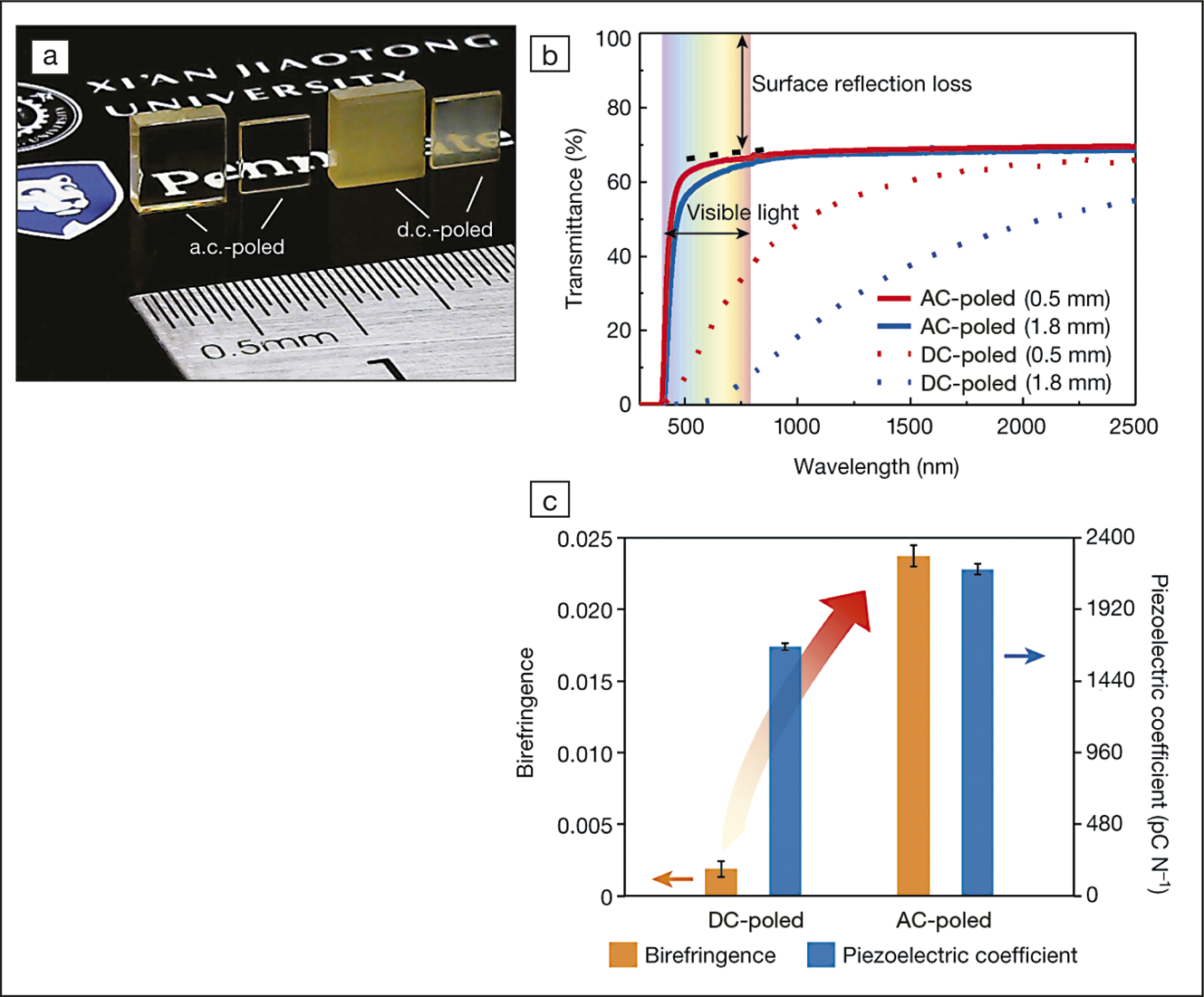Guided by simulations, researchers from The Pennsylvania State University and Xi’an Jiaotong University have found a method for simultaneously increasing the transparency and piezoelectricity of rhombohedral lead magnesium niobite-lead titanate (PMN-28PT) crystals. The research team’s study was published recently in Nature (doi:10.1038/s41586-019-1891-y) and could be used to create better responsive, transparent touch screens.
In many materials, it is a challenge to achieve transparency without sacrificing piezoelectric performance. Piezoelectric materials respond mechanically to an electric force and produce an electric signal under a mechanical force. The most important class of piezoelectric materials are ferroelectric materials that contain domains of permanent electric polarization. Without special treatment, these ferroelectric domains are randomly oriented along different crystallographic directions. To create piezoelectric devices, ferroelectric materials are poled, or exposed to an electric field, to align the different polarizations. Materials with high piezoelectricity have used poling to create engineered domain structures containing several types of ferroelectric domains separated by domain walls. “These domain walls severely scatter light, and hence these engineered domain structures are generally opaque,” says Long-Qing Chen of The Pennsylvania State University and a corresponding author of the recent Nature publication.

(a) Photograph of two AC- (left, clear) and two DC- (right, yellow) poled rhombohedral Pb(Mg1/3Nb2/3)O3·PbTiO3 (PMN-PT) crystals. The thicknesses of the two crystals are 0.5 mm and 1.8 mm, respectively. (b) Light transmittance of the AC- (red line and dots) and DC- (blue line and dots) poled PMN-PT crystals. (c) Piezoelectric coefficient and birefringence of the AC- and DC-poled PMN-28PT crystals. The red graded arrow sho ws the increase in the two properties for PMN-PT crystals after AC poling. Credit: Nature.
The new results using PMN-28PT demonstrate that piezoelectric crystals containing domain walls can also be made transparent. Using a software package developed by Chen’s group, the research team simulated the behavior of the PMN-28PT under both AC- and DC-electric fields, or AC- and DC-poling, respectively. While DC-poling has been widely used, their simulations showed that AC-poling gradually reduced the number of light-scattering domain walls in the PMN-28PT crystal. Under the AC electric field, the different ferroelectric domains merge as they “swing” back and forth, which led to a drastic reduction in the number of domains over time. Subsequent theoretical calculations confirmed that larger domain sizes lead to larger piezoelectric responses in the PMN-28PT crystals.
Led by Zhuo Xu and Fei Li, the researchers at Xi’an Jiaotong University then used the simulation results to guide their processing of the PMN-28PT crystals to achieve high transparency. Building on a technique established 20 years ago for growing this material, Xu and Li developed an additional thermal annealing process. First, the samples were heated to 300°C for five hours and then cooled slowly to room temperature. Afterward, the crystals were allowed to rest for 5–7 days, which further increased their transparency by releasing their internal stress. The samples were then poled to attain their final transparency.
Xu and Li then used various optical and electric-field-induced-strain meas-urements to characterize the transparency and piezoelectric responses of the AC- and DC-poled PMN-28PT crystals. The birefringence of the AC-poled sample was significantly higher, which demonstrates that it contained fewer light-scattering domain walls than the DC-poled sample. The AC-poled sample also had a much higher transmission for visible and near-infrared light. Lastly, the piezoelectric coefficient was 30% higher in the AC sample compared to the DC sample.
“The AC field was much more effective for controlling the domain boundaries [in PMN-28PT] than the DC field, to the point where the AC field made the samples almost completely transparent,” says Alexander Paterson of Ames Laboratory, who was not connected with the work.
Chen, Xu, and Li are currently exploring other compounds within the PMN-PT family, such as doped PMN-PT or lead indium niobate-lead magnesium niobate-lead titanate (PIN-PMN-PT). They have demonstrated similar results with higher piezoelectric coefficients in samarium-doped PMN-PT (doi:10.1126/science.aaw2781). The optical, electrical, and mechanical properties of transparent piezoelectric materials could also be used to improve devices such as touch screens or medical photoacoustic imaging microscopes.
Beyond transparent piezoelectrics, this collaboration demonstrates the advantage of combining simulation and mesoscale engineering of materials to target desirable properties. “This work is [a very successful example] of computation-guided discovery and design of materials,” Chen says.




